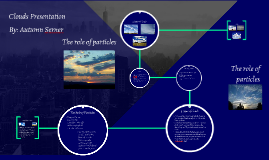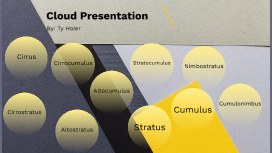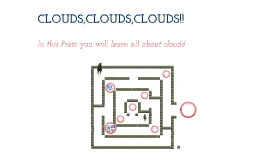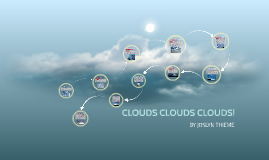CLOUDS CLOUDS CLOUDS!
Transcript: NIMBOSTRATUS CLOUDS CUMULUS CLOUDS CIRROCUMULUS CLOUDS ALTOCUMULUS CLOUDS CIRRUS CLOUDS Cirrus clouds are thin and wispy clouds, blown by high winds into long steamers Considered "high clouds", forming above 20,000 feet high Generally mean fair to pleasant weather Stratus clouds are greyish clouds that often covers the entire sky Considered "low" clouds Usually no precipitation falls from these clouds, but they may drizzle CUMULONIMBUS CLOUDS Cirrostratus clouds are thin, sheetlike clouds that cover the entire the sky High clouds These clouds usually come 12-24 hours before a rain or snow storm MAMMATUS CLOUDS BY JOSLYN THIEME Cumulonimbus clouds are big clouds with dark bases The base is about no more but 1,000 feet in above the air, but their tops can go up to about 39,000 feet above the ground These clouds are mainly thunderstorm clouds and lightning, thunder, and even violent tornados are associated with this cloud Altocumulus clouds are made of water droplets and appear as grey, puffy clouds These clouds form at a "middle" level The appearance of these clouds on a warm, humid summer morning usually means thunderstorms in the afternoon Unlike most clouds, mammatus clouds form from sinking air, where other form from rising air Considered "low" level clouds, that droop from a cumulonimbus cloud These clouds are often associated with severe weather Cumulus clouds are puffy clouds that sometimes look like floating cotton The base of these clouds are usually flat and only are about 3,300 above the ground These clouds grow upward, which can turn into giant cumulonimbus clouds, thunderstorm clouds Altostratus clouds are grey or blue-grey clouds composed of ice crystals and water droplets Considered "middle level" clouds These clouds often form a head of storms producing continuous precipitation Nimbostratus clouds are a dark grey, "wet" looking cloud Considered "low" clouds Often produce precipitation that is light or moderate CIRROSTRATUS CLOUDS STRATUS CLOUDS Cirrocumulus clouds are small, white rounded puffs Considered "high clouds", forming above 16,000 Usually seen in the winter time and indicate fair, but cold, weather ALTOSTRATUS CLOUDS CLOUDS CLOUDS CLOUDS!

















